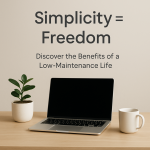Frugality and Personal Finance: The Winning Duo for Your Wealth Journey
If you’ve ever wondered how some people seem to achieve financial freedom faster than others, the answer often lies in mastering frugality and personal finance. These two powerhouse habits work hand-in-hand to help you save smarter, invest better, and live with less financial stress. Frugality isn’t about being cheap — it’s about being intentional with every dollar. Combined with smart personal finance management, frugality can unlock a life of abundance and choice.
Today, we’re diving deep into what frugality and personal finance really mean, how they can drastically improve your life, and proven strategies to make them work for you.
What is Frugality?
Frugality is often misunderstood. It’s not just about clipping coupons or buying generic brands. True frugality is about maximizing value. It’s making deliberate choices to prioritize what matters most while cutting wasteful spending.
The Real Definition of Frugality
According to the Merriam-Webster Dictionary, frugality means “careful management of material resources and especially money.” Notice how it doesn’t say “cheap” or “stingy”? Frugal living means being resourceful, not restrictive.
Why Frugality and Personal Finance Go Hand-in-Hand
Mastering your personal finances without practicing frugality is like trying to fill a bucket with holes in it. No matter how much money you make, if you’re not mindful about your spending habits, true wealth will slip through your fingers.
Study Spotlight: The Millionaire Mind
In Thomas J. Stanley’s bestselling book The Millionaire Next Door, research revealed that the majority of self-made millionaires live modestly. They drive used cars, live in average neighborhoods, and avoid unnecessary luxury expenses. Frugality was a key trait among the wealthy — not income alone.
The Core Benefits of Practicing Frugality in Your Personal Finances
Let’s break down the incredible upsides:
1. Financial Freedom Becomes Attainable
When you spend less, you save more. It’s simple math. And the more you save, the sooner you can invest, build wealth, and reach financial independence.
Study Reference: FIRE Movement
The FIRE (Financial Independence, Retire Early) movement is based largely on extreme frugality and aggressive saving. A study from the University of Colorado found that FIRE adherents typically save 50–70% of their income — drastically shortening their working years.
2. Reduced Financial Stress
A survey by the American Psychological Association found that 72% of adults feel stressed about money. Practicing frugality reduces unnecessary spending, cushions your savings, and eliminates the constant paycheck-to-paycheck anxiety.
3. Increased Flexibility and Opportunity
Want to start a business? Take a sabbatical? Move to a new city? Frugality builds the financial cushion that turns dreams into realistic options.
How to Practice Frugality Without Feeling Deprived
You might worry that adopting a frugal lifestyle means missing out. Good news: smart frugality is all about value — not denial.
Mindful Spending vs. Mindless Spending
Track Your Expenses First
You can’t improve what you don’t measure. Apps like Mint, YNAB (You Need A Budget), or even a simple spreadsheet can help you understand your current spending patterns.
Focus on Big Wins, Not Pennies
Cutting lattes won’t make you rich — but negotiating your rent, refinancing a loan, or eliminating car payments might. Focus on big-ticket items where frugality pays the highest dividends.
Example:
- Move to a smaller, affordable apartment.
- Buy a reliable used car instead of a new one.
- Cut recurring subscriptions you don’t need.
Embrace the 30-Day Rule
Before buying anything non-essential, wait 30 days. Chances are you’ll realize you didn’t need it after all. This habit can save thousands a year without feeling like sacrifice.
Smart Personal Finance Strategies to Supercharge Your Frugal Lifestyle
Budgeting is Your Best Friend
Think of your budget as permission to spend — wisely.
The 50/30/20 Rule
- 50% to needs (housing, food, bills)
- 30% to wants (entertainment, hobbies)
- 20% to savings and debt repayment
This simple framework can help even financial novices balance frugality and fun.
Build an Emergency Fund
Frugality without a safety net is risky. Experts recommend 3–6 months’ worth of expenses saved in a high-yield savings account.
According to a Bankrate survey, only 39% of Americans could cover a $1,000 unexpected expense from savings. Don’t be part of the vulnerable majority.
Invest Early and Often
Saving is great. Investing is better.
- Open a 401(k) through your employer (especially if they match contributions).
- Use a Roth IRA for tax-free growth.
- Explore low-cost index funds and ETFs.
Even small investments, compounded over decades, can turn into a fortune — thanks to the magic of compound interest.
Frugality in Daily Life: Simple Habits That Add Up Big
DIY Whenever Possible
YouTube can teach you how to fix a leaky faucet, sew a button, or cook restaurant-quality meals at home. Each skill saves money over hiring out.
Master the Art of Secondhand Shopping
Buying secondhand isn’t just for clothes anymore. Think furniture, appliances, electronics. Sites like Facebook Marketplace, OfferUp, and Poshmark offer insane value if you’re patient.
Meal Plan and Cook at Home
According to a study by the Bureau of Labor Statistics, the average American household spends $3,000 a year eating out. Meal planning and prepping can cut that in half while keeping you healthier.
The Psychology Behind Frugality: Why Mindset Matters
It’s not just about cutting costs — it’s about changing your relationship with money.
Instant Gratification vs. Long-Term Satisfaction
Research from Stanford’s famous Marshmallow Experiment showed that children who delayed gratification grew into more successful adults. Practicing frugality is adult-level delayed gratification: trading short-term wants for long-term wealth.
Practicing Gratitude
Gratitude helps you appreciate what you already have, reducing the urge to buy more. Journaling three things you’re grateful for daily can shift your focus away from materialism toward contentment.
Common Myths About Frugality and Personal Finance
Let’s bust a few misconceptions.
Myth 1: You Have to Be Poor to Be Frugal
Reality: The wealthiest individuals often practice the most intentional spending. Frugality is a choice, not a consequence.
Myth 2: Frugality Means Being Miserable
Reality: Strategic frugality creates more room for joy and freedom by eliminating financial stress.
Myth 3: You Need Six Figures to Master Personal Finance
Reality: Personal finance is about how much you keep, not just how much you earn. Good habits beat high incomes when it comes to building wealth.
Resources to Help You Master Frugality and Personal Finance
Books:
- The Simple Path to Wealth by JL Collins
- Your Money or Your Life by Vicki Robin
- I Will Teach You to Be Rich by Ramit Sethi
Websites:
- Mr. Money Mustache (Frugality and FIRE)
- NerdWallet (Financial tools and advice)
Apps:
- Mint (Budgeting)
- YNAB (Proactive Budgeting)
- Personal Capital (Investment Tracking)
Final Thoughts: Frugality and Personal Finance Are Superpowers
Mastering frugality and personal finance isn’t about living a life of restriction — it’s about designing a life of freedom. It’s about buying your time back, creating options, and building lasting wealth that can weather any storm.
Start small. Stay consistent. Focus on value. Your future self will thank you.
Bottom Line:
By blending mindful frugality with smart financial planning, you’re not just saving money — you’re creating a life on your terms.



